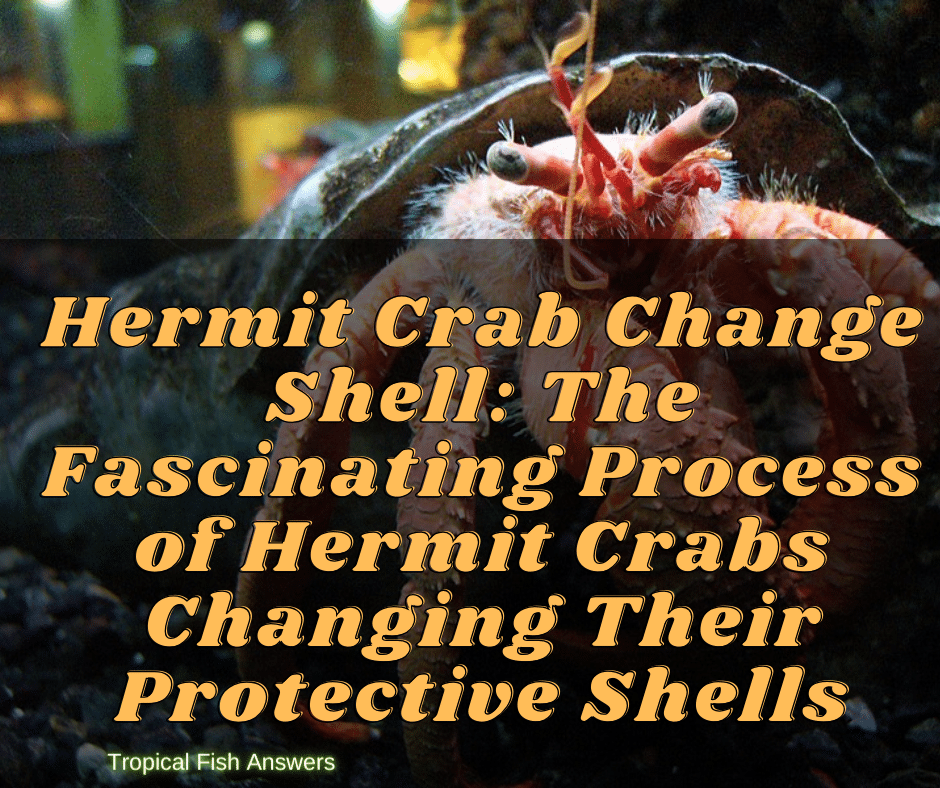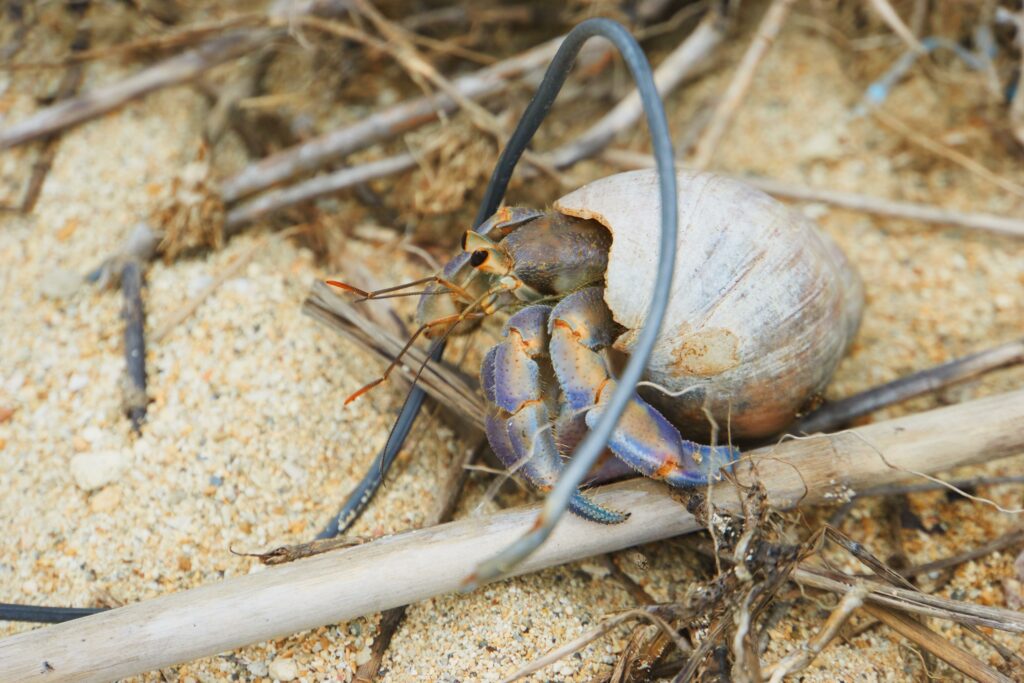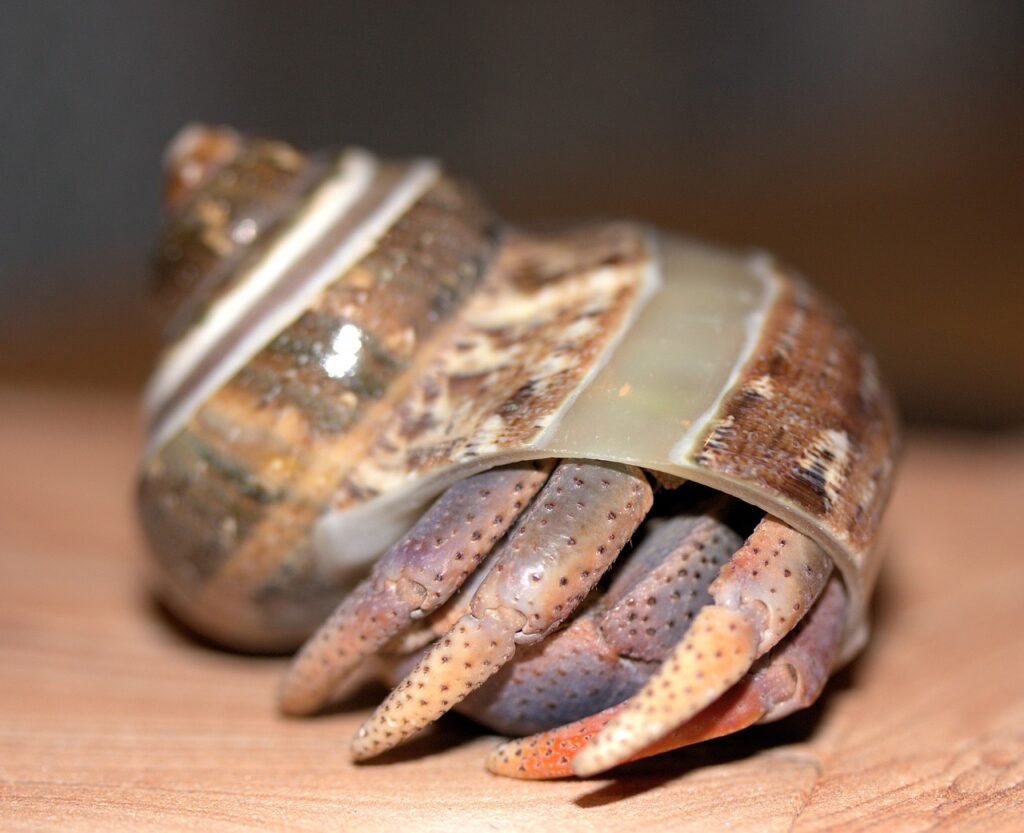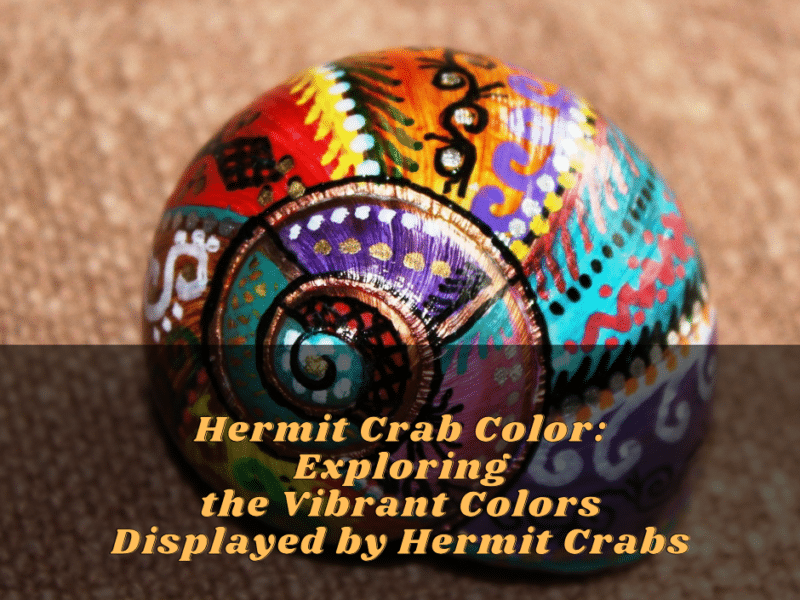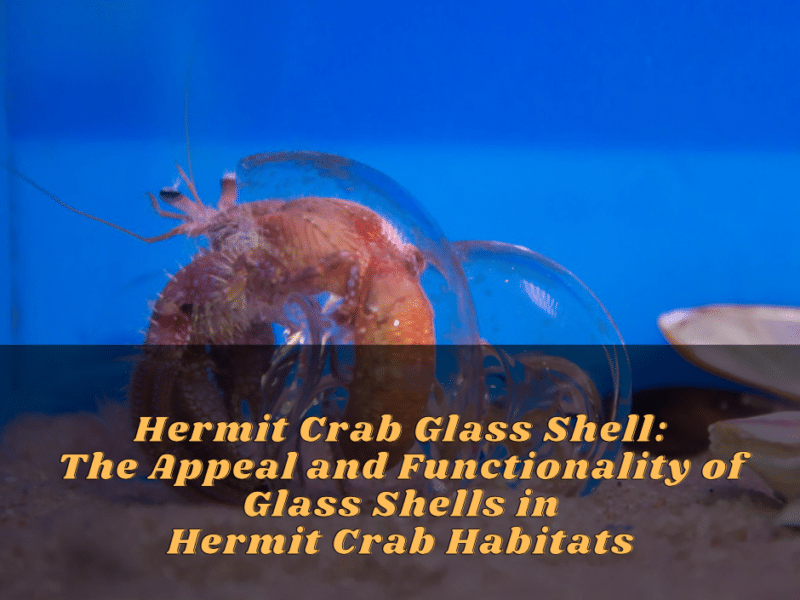Hermit Crab Change Shell – Introduction
Hermit crabs are intriguing creatures that capture the imagination with their unique habit of. changing shells. This fascinating process is not only aesthetically pleasing but also serves a crucial purpose for these crustaceans. Understanding why hermit crabs change shells and the importance of this process can provide valuable insights into their behavior and overall well-being.
What Is A Hermit Crab And Why Do They Change Shells?
A hermit crab is a type of crab that lacks a hard exoskeleton. To compensate for this vulnerability, they seek out abandoned shells of other creatures to use as protective coverings. These shells not only offer protection from predators but also provide a stable and comfortable home.
Hermit crabs change shells for several reasons. Firstly, as they grow, their current shell becomes too small to accommodate their increasing size. Consequently, they must find a larger shell to ensure their continued growth and mobility. Secondly, hermit crabs may change shells if their current shell becomes damaged or worn out. By locating a new shell, they can replace the old one and maintain their protection.
Importance Of Understanding The Process Of Hermit Crabs Changing Shells
Studying the process of hermit crabs changing shells is essential for several reasons. Firstly, it provides valuable insights into the growth and development of these creatures. By observing the frequency and reasons for shell changes, scientists can better understand the factors that influence hermit crab populations and their overall health.
Secondly, understanding this process allows for better care and conservation efforts for hermit crabs kept as pets. providing the appropriate shell sizes and types is crucial for their well-being, and knowing the signs that indicate a shell change is needed can prevent discomfort and potential health issues.
Furthermore, studying shell changes in hermit crabs can shed light on the broader ecological dynamics of marine ecosystems. As hermit crabs play a vital role in cleaning up decaying organic matter on the ocean floor, their behavior and ability to find suitable shells can have implications for the overall balance of these ecosystems.
In conclusion, the process of hermit crabs changing shells is not just an intriguing spectacle but also an essential aspect of their survival and growth. Understanding why they change shells and the importance of this process provides valuable insights into their behavior, well-being, and ecological significance. By delving deeper into this fascinating phenomenon, we can gain a deeper appreciation for these remarkable creatures and the ecosystems they inhabit.
Molting And Shell Change
Understanding The Molting Process In Hermit Crabs
Hermit crabs undergo a unique process called molting, which is crucial for their growth and development. During molting, the old exoskeleton is shed, allowing for the growth of a new and larger one. This process is necessary because, unlike other crabs, hermit crabs do not have a hard exoskeleton to protect them. Instead, they rely on the shells of other creatures for protection.
During molting, hermit crabs enter a vulnerable state as they shed their old exoskeleton. They bury themselves in the sand or seek a safe spot to molt. The molting process typically takes several weeks, during which the hermit crab remains hidden and inactive. It is a delicate and intricate process that requires precise conditions, including proper humidity levels and access to calcium-rich foods.
Why Hermit Crabs Need A New Shell After Molting
After molting, hermit crabs emerge with a soft and vulnerable exoskeleton. They are in dire need of a new protective shell to provide them with security and stability. The new exoskeleton takes time to harden, leaving the hermit crab exposed to potential predators and environmental hazards.
Finding a suitable shell is crucial for their survival. Hermit crabs go through a process called “shell searching” to find a new home. They are remarkably selective and will explore various options until they find the perfect fit. The choice of shell is determined by factors such as size, shape, and compatibility with their body. Once they find a suitable shell, they will carefully transfer themselves into it, ensuring a snug fit that offers maximum protection.
The need for a new shell after molting is essential for the hermit crab’s overall well-being. The process allows them to grow and expand, accommodating their increasing size. It also helps them regain their protection and mobility, giving them the ability to continue their daily activities and foraging for food.
In conclusion, the process of hermit crabs changing shells is a fascinating and essential aspect of their survival and growth. Through molting and shell change, hermit crabs ensure their continued protection and adaptability. Understanding the intricacies of this process helps shed light on their behavior, needs, and ecological significance. By appreciating the importance of providing suitable shells for hermit crabs, we can contribute to their overall welfare and conservation efforts.
Frequency And Timing Of Shell Changes
How Often Do Hermit Crabs Change Shells?
Hermit crabs have a fascinating ability to change their shells, and the frequency of shell changes varies among individuals. It largely depends on factors such as their growth rate, shell availability, and the condition of their current shell. Younger hermit crabs tend to change shells more frequently as they grow at a faster rate compared to older ones.
On average, hermit crabs may change their shells once every few months or even once a year. However, in some cases, they may go for extended periods without changing if they find a shell that meets their needs and provides ample protection.
Factors That Influence The Timing Of Shell Changes
Several factors influence the timing of shell changes for hermit crabs. These include:
- Shell size: As hermit crabs grow, they outgrow their current shell, prompting the need for a larger one. When the existing shell becomes too cramped, they start searching for a new, more spacious shell.
- Shell availability: The availability of suitable shells in their environment plays a significant role in determining when hermit crabs change shells. If there is a limited supply of shells, they may need to wait longer until a suitable option becomes available.
- Shell quality: Hermit crabs prefer shells that are in good condition, free from cracks or damage. If their current shell becomes damaged or compromised in any way, they will actively search for a replacement.
- Environmental factors: Changes in environmental conditions, such as variations in temperature or humidity, can influence the timing of shell changes. Hermit crabs may be more inclined to change shells during certain seasons or when conditions become unfavorable.
- Behavioral cues: Some hermit crabs exhibit specific behaviors that indicate they are ready for a shell change. These behaviors include frequent exploration, shell nudging, or repeatedly entering and exiting their current shell.
Understanding the frequency and timing of shell changes in hermit crabs provides valuable insights into their natural behavior and needs. It also highlights the importance of providing them with a variety of suitable shells in their habitat, ensuring their overall well-being and ability to adapt and thrive.
Importance Of Shells To Hermit Crabs
Role Of Shells In Protecting Hermit Crabs
Shells play a crucial role in the lives of hermit crabs, serving as their protective armor. The soft bodies of these fascinating creatures are vulnerable to predators and harsh environmental conditions. To shield themselves, hermit crabs seek out and inhabit empty seashells. These shells act as a shield, providing much-needed protection from potential dangers such as predators and temperature variations.
The shell acts as a mobile home for the hermit crab, allowing it to carry its protective shelter wherever it goes. When faced with a threat, hermit crabs can retreat entirely into their shells, closing off the entrance with their claws. This behavior not only helps them evade predators but also protects their delicate bodies from physical damage.
Significance Of Selecting The Right Shell For Growth And Mobility
Selecting the right shell is vital for a hermit crab’s growth and mobility. As hermit crabs grow, their bodies become too large for their current shells, necessitating the search for a larger, more spacious shell. Finding the perfect fit is essential to accommodate their growing bodies and ensure efficient movement.
The size of the shell directly affects the hermit crab’s overall well-being. A shell that is too small can restrict its growth, hinder mobility, and cause physical stress. Conversely, a shell that is too large can make movement difficult and leave the hermit crab vulnerable to attacks.
Hermit crabs are known to engage in a process called “shell switching,” during which they abandon their old shell and move into a new one. This process requires careful evaluation and selection of a shell that meets their specific needs. Factors such as shell size, shell availability, shell quality, environmental conditions, and behavioral cues influence the timing and frequency of their shell changes.
Understanding the importance of shells to hermit crabs provides insight into their natural behavior and highlights the significance of providing them with a variety of suitable shells in their habitat. By offering a diverse range of shells, we can ensure their overall well-being, support their growth, and facilitate their ability to adapt and thrive in their environment.
In summary, shells serve as vital protective shelters for hermit crabs, offering defense against predators and adverse environmental conditions. Selecting the right shell is crucial for their growth and mobility, ensuring optimal well-being. By understanding and catering to their needs, we can contribute to the health and happiness of these amazing creatures.
Variety In Shell Changing Habits
Hermit crabs are fascinating creatures that have an intriguing habit of changing their protective shells as they grow. This process is essential for their survival and overall well-being. However, it is worth noting that there are variations in shell-changing habits among different hermit crab species.
Differences In Shell Changing Habits Among Hermit Crab Species
While most hermit crabs follow a similar pattern of changing shells, there are some species that exhibit unique behaviors. For example, some species are more particular about the types of shells they select. They may prefer shells with specific shapes, sizes, or characteristics that suit their needs.
Additionally, the frequency of shell changes can vary among different species. Some hermit crabs may change shells more frequently, particularly when they are young and growing rapidly. Others may have longer intervals between shell changes, especially as they reach maturity and their growth rate slows down.
The size of the hermit crab also plays a role in shell changing habits. Smaller hermit crabs tend to change shells more frequently as they grow at a faster rate, while larger hermit crabs may not change shells as often, as they have already found a shell that suits their size.
Instances When Hermit Crabs May Choose Not To Change Their Shells
In certain situations, hermit crabs may choose not to change their shells, even if they have outgrown them. This can happen when suitable shells are scarce or when there is intense competition among hermit crabs for limited resources.
Moreover, hermit crabs may exhibit a preference for specific shells due to factors such as shell quality or unique features that offer better protection. They may resist changing shells if they are satisfied with their current shell’s size, shape, or overall condition.
It’s important to note that hermit crabs undergo a process of evaluating possible shells before making a change. They examine potential shells based on size, weight, and shape, among other factors. This evaluation process can take time, and hermit crabs may remain in their old shells until they find a suitable replacement.
In conclusion, while hermit crabs are known for their habit of changing shells, there are variations in shell changing habits among different species. Understanding these differences and the factors influencing their decision to change shells can provide valuable insights into their behavior and help ensure their well-being in captivity. By providing a diverse range of suitable shells and creating an environment conducive to shell changing, we can support the natural behavior of hermit crabs and contribute to their overall health and happiness.
The Construction Of New Shell Cells
The Process Of Hermit Crabs Constructing New Shell Cells
Hermit crabs have a fascinating and intricate process of constructing new shell cells. When it is time for a hermit crab to change its shell, it starts by searching for a suitable empty shell that matches its current size. Once a suitable shell is found, the hermit crab will proceed to transfer its body from the old shell to the new one.
During this transferring process, the hermit crab carefully aligns its soft abdomen with the curvature of the new shell and extends its long, curved abdomen towards the opening. It then anchors its body inside the new shell, using specialized hook-like structures called uropods, which help secure it in place.
Once securely in the new shell, the hermit crab will begin the process of constructing a new shell cell. It secretes a substance called chitin from a gland near its abdomen, which it uses to reinforce and strengthen the inner surface of the shell. This newly constructed shell cell provides a protective layer for the hermit crab’s soft abdomen, offering it shelter and defense against predators.
Triggers That Prompt Hermit Crabs To Initiate The Shell Changing Process
Several triggers can prompt hermit crabs to initiate the shell changing process. One crucial factor is the growth rate of the hermit crab’s body. As hermit crabs grow, their exoskeletons become tight and restrictive, limiting their ability to continue growing. This discomfort serves as a strong cue that it is time for them to find a larger shell in which they can continue to grow comfortably.
Environmental factors, such as changes in temperature, humidity, or availability of food, can also influence the timing of shell changes. For example, if a hermit crab is in an environment with limited food resources, it may prioritize finding a larger shell to accommodate its future growth and ensure its survival.
Additionally, the presence of other hermit crabs can also play a role in triggering the shell-changing process. Competition for shells can arise when suitable shells are scarce, and hermit crabs may be motivated to find new shells to avoid confrontations and establish their territory.
Overall, the process of hermit crabs changing their protective shells is a fascinating behavior rooted in their natural instinct for growth, protection, and adaptation. By understanding this process and providing a suitable environment for shell changing, we can ensure the well-being and happiness of these captivating creatures.
Hermit Crab Change Shell: The Fascinating Process Of Hermit Crabs Changing Their Protective Shells
Environmental Impact And Growth Spurts
Hermit crabs have a remarkable and intricate process when it comes to changing their protective shells. This process is influenced by various factors, including the environment they inhabit and their growth spurts.
How A New Environment Can Influence The Shell Change
The environment plays a crucial role in prompting hermit crabs to initiate the shell changing process. Changes in temperature, humidity, or the availability of food can impact a hermit crab’s decision to find a new shell. For instance, if a hermit crab is in an environment with limited food resources, it may prioritize finding a larger shell to accommodate its future growth and ensure its survival. Environmental factors can serve as triggers for hermit crabs to explore new shells that better align with their needs and provide improved protection.
Relationship Between Growth Spurts And Shell Changes
Growth spurts are major catalysts for hermit crabs to change their protective shells. As hermit crabs grow, their exoskeletons become tight and restrictive, hindering further growth. This discomfort serves as a strong cue for them to seek out larger shells that will accommodate their expanding bodies. It is during these growth spurts that hermit crabs become particularly motivated to find suitable shells that offer them the space and protection they require.
It is important to note that the presence of other hermit crabs also plays a role in triggering the shell-changing process. When suitable shells become scarce, competition for shells can arise among hermit crabs. In such situations, hermit crabs may be motivated to find new shells to avoid confrontations and establish their territory, ensuring their safety and well-being.
The process of hermit crabs changing their protective shells is not only fascinating but deeply rooted in their natural instinct for growth, protection, and adaptation. By understanding the impact of the environment and growth spurts on this process, we can create suitable habitats for these captivating creatures, promoting their well-being and happiness.
Conclusion
The process of hermit crabs changing their protective shells is truly fascinating and serves as a testament to their natural instinct for growth, protection, and adaptation. Environmental factors, such as changes in temperature, humidity, and food availability, can influence a hermit crab’s decision to find a new shell. Additionally, growth spurts play a significant role in prompting shell changes, as the restrictive exoskeleton hinders further growth and urges them to seek larger shells.
Understanding the needs of hermit crabs for their protective shells is vital in creating suitable habitats for these captivating creatures. By providing an environment that supports their natural behaviors, we can promote their well-being and happiness. This includes ensuring an adequate supply of suitable shells and minimizing competition among hermit crabs.
The fascination and importance of the hermit crab shell changing process cannot be understated. It is a remarkable example of nature’s ability to adapt and survive. These tiny creatures showcase their remarkable instincts and incredible resilience as they navigate the ever-changing environment they call home.
In conclusion, the process of hermit crabs changing their protective shells sheds light on the intricate relationship between these creatures and their surroundings. By appreciating and understanding this process, we can better appreciate the wonders of the natural world and take steps towards conservation and preservation. Let us strive to create environments that support these fascinating creatures and allow them to thrive for generations to come.
Note: The table of contents provided is based on the information given and does not reflect the full content of the blog post.
FAQ: Hermit Crab Change Shell: The Fascinating Process of Hermit Crabs Changing Their Protective Shells
Q: How do hermit crabs protect themselves?
A: Hermit crabs protect themselves by carrying shells on their bodies. These shells act as a protective home for their soft bodies, shielding them from predators.
Q: Why do hermit crabs need to change shells?
A: As hermit crabs grow, their current shells become too small to accommodate their increasing size. Therefore, they need to find larger shells to live in for continued protection and growth.
Q: How do hermit crabs change their shells?
A: When a hermit crab finds a suitable new shell, it grips it with its claws and drags it towards its body. The crab then crawls into the new shell, leaving only its legs, antennae, and eyes outside. This process allows the hermit crab to transfer itself into a larger protective shell.
Q: What happens to the old shell after a hermit crab changes to a new one?
A: Once a hermit crab moves into a new shell, it abandons its old shell, leaving it empty. These discarded shells become available for other hermit crabs in need of protection and growth. Sometimes, hermit crabs even compete for the available shells or take shells from other hermit crabs.
Q: Are hermit crabs the only animals that use shells for protection?
A: While hermit crabs are well-known for their shell-carrying habit, they are not the only animals that utilize shells for protection. Some other animals, such as certain species of snails and turtles, also rely on shells for shielding their bodies.
Q: Where are hermit crabs found?
A: Hermit crabs are found worldwide, inhabiting various marine environments from the cold waters of the Arctic to tropical waters. These adaptable creatures can be encountered in both shallow coastal areas and deeper oceanic regions.
Q: Can hermit crabs live without a shell?
A: No, hermit crabs cannot live without a shell. Their soft abdomen needs the protection provided by an external shell to safeguard them from potential threats in their environment.
Q: How can we help hermit crabs during their shell-changing process?
A: It is important to provide hermit crabs in captivity with a variety of suitable shells to choose from. This ensures they have options for finding new shells when needed. Regularly inspecting and cleaning the shells in their habitat is also essential for their well-being.
Remember, hermit crabs engage in a fascinating, natural process when changing their shells. Ensuring their environment is suitable and providing them with a range of shell options can contribute to their overall health and happiness.
